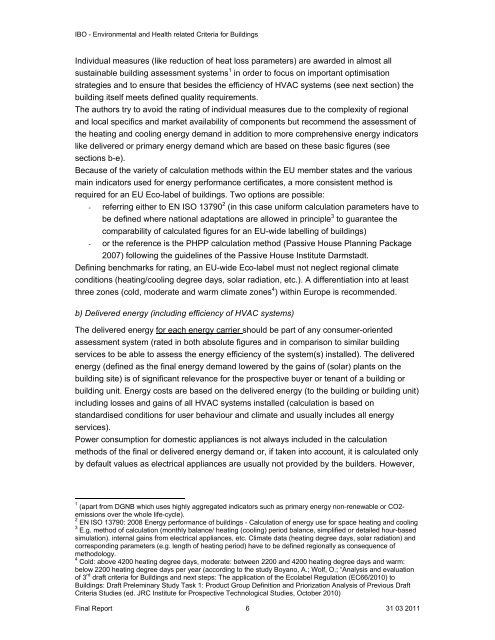Environmental and health related criteria for buildings - ANEC
Environmental and health related criteria for buildings - ANEC
Environmental and health related criteria for buildings - ANEC
Create successful ePaper yourself
Turn your PDF publications into a flip-book with our unique Google optimized e-Paper software.
IBO - <strong>Environmental</strong> <strong>and</strong> Health <strong>related</strong> Criteria <strong>for</strong> Buildings<br />
Individual measures (like reduction of heat loss parameters) are awarded in almost all<br />
sustainable building assessment systems 1 in order to focus on important optimisation<br />
strategies <strong>and</strong> to ensure that besides the efficiency of HVAC systems (see next section) the<br />
building itself meets defined quality requirements.<br />
The authors try to avoid the rating of individual measures due to the complexity of regional<br />
<strong>and</strong> local specifics <strong>and</strong> market availability of components but recommend the assessment of<br />
the heating <strong>and</strong> cooling energy dem<strong>and</strong> in addition to more comprehensive energy indicators<br />
like delivered or primary energy dem<strong>and</strong> which are based on these basic figures (see<br />
sections b-e).<br />
Because of the variety of calculation methods within the EU member states <strong>and</strong> the various<br />
main indicators used <strong>for</strong> energy per<strong>for</strong>mance certificates, a more consistent method is<br />
required <strong>for</strong> an EU Eco-label of <strong>buildings</strong>. Two options are possible:<br />
- referring either to EN ISO 13790 2 (in this case uni<strong>for</strong>m calculation parameters have to<br />
be defined where national adaptations are allowed in principle 3 to guarantee the<br />
comparability of calculated figures <strong>for</strong> an EU-wide labelling of <strong>buildings</strong>)<br />
- or the reference is the PHPP calculation method (Passive House Planning Package<br />
2007) following the guidelines of the Passive House Institute Darmstadt.<br />
Defining benchmarks <strong>for</strong> rating, an EU-wide Eco-label must not neglect regional climate<br />
conditions (heating/cooling degree days, solar radiation, etc.). A differentiation into at least<br />
three zones (cold, moderate <strong>and</strong> warm climate zones 4 ) within Europe is recommended.<br />
b) Delivered energy (including efficiency of HVAC systems)<br />
The delivered energy <strong>for</strong> each energy carrier should be part of any consumer-oriented<br />
assessment system (rated in both absolute figures <strong>and</strong> in comparison to similar building<br />
services to be able to assess the energy efficiency of the system(s) installed). The delivered<br />
energy (defined as the final energy dem<strong>and</strong> lowered by the gains of (solar) plants on the<br />
building site) is of significant relevance <strong>for</strong> the prospective buyer or tenant of a building or<br />
building unit. Energy costs are based on the delivered energy (to the building or building unit)<br />
including losses <strong>and</strong> gains of all HVAC systems installed (calculation is based on<br />
st<strong>and</strong>ardised conditions <strong>for</strong> user behaviour <strong>and</strong> climate <strong>and</strong> usually includes all energy<br />
services).<br />
Power consumption <strong>for</strong> domestic appliances is not always included in the calculation<br />
methods of the final or delivered energy dem<strong>and</strong> or, if taken into account, it is calculated only<br />
by default values as electrical appliances are usually not provided by the builders. However,<br />
1 (apart from DGNB which uses highly aggregated indicators such as primary energy non-renewable or CO2-<br />
emissions over the whole life-cycle).<br />
2 EN ISO 13790: 2008 Energy per<strong>for</strong>mance of <strong>buildings</strong> - Calculation of energy use <strong>for</strong> space heating <strong>and</strong> cooling<br />
3 E.g. method of calculation (monthly balance/ heating (cooling) period balance, simplified or detailed hour-based<br />
simulation). internal gains from electrical appliances, etc. Climate data (heating degree days, solar radiation) <strong>and</strong><br />
corresponding parameters (e.g. length of heating period) have to be defined regionally as consequence of<br />
methodology.<br />
4 Cold: above 4200 heating degree days, moderate: between 2200 <strong>and</strong> 4200 heating degree days <strong>and</strong> warm:<br />
below 2200 heating degree days per year (according to the study Boyano, A.; Wolf, O.; “Analysis <strong>and</strong> evaluation<br />
of 3 rd draft <strong>criteria</strong> <strong>for</strong> Buildings <strong>and</strong> next steps: The application of the Ecolabel Regulation (EC66/2010) to<br />
Buildings: Draft Preleminary Study Task 1: Product Group Definition <strong>and</strong> Priorization Analysis of Previous Draft<br />
Criteria Studies (ed. JRC Institute <strong>for</strong> Prospective Technological Studies, October 2010)<br />
Final Report 6 31 03 2011
















